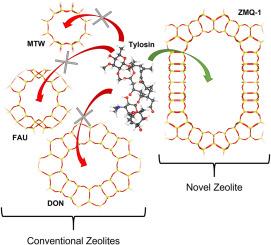新兴的特大孔沸石作为抗生素吸附剂:比较计算研究
IF 4.7
3区 材料科学
Q1 CHEMISTRY, APPLIED
引用次数: 0
摘要
近年来,具有超大孔径的铝硅酸盐和全硅沸石的合成为材料科学开辟了新的机遇。除了它们的催化应用之外,这些新型材料还能独特地吸附非常大的分子,这是传统沸石由于孔径限制而无法实现的能力,因此阻碍了此类化合物的吸附研究。这项工作通过研究各种抗生素在疏水超大孔沸石中的吸附,探索了这些材料的新用例,摩尔质量高达900 g/mol。我们强调这些先进的沸石在关键应用方面的巨大潜力,如从废水中去除抗生素和开发新的药物输送系统。采用经典的基于力场的模拟,我们解释了控制特定抗生素和超大孔沸石框架之间强相互作用组合形成的主要分子结构-拓扑关系。本文章由计算机程序翻译,如有差异,请以英文原文为准。

Emerging extra-large pore zeolites as adsorbents for antibiotics: A comparative computational study
The recent synthetic accessibility of aluminosilicate and all-silica zeolites with extremely large pore sizes opens new opportunities in materials science. Beyond their catalytic applications, these novel materials uniquely enable the adsorption of very large molecules—a capability previously unrealized with conventional zeolites due to pore size restrictions, which consequently hindered adsorption studies of such compounds. This work explores new use cases for these materials by investigating the adsorption of various antibiotics, with molar masses up to 900 g/mol, in hydrophobic extra-large pore zeolites. We highlight the significant potential of these advanced zeolites for critical applications, like the removal of antibiotics from wastewater and the development of novel drug delivery systems. Employing classical forcefield-based simulations, we explain the main molecular structure-topology relationships that govern the formation of strongly interacting combinations between specific antibiotics and extra-large pore zeolite frameworks.
求助全文
通过发布文献求助,成功后即可免费获取论文全文。
去求助
来源期刊

Microporous and Mesoporous Materials
化学-材料科学:综合
CiteScore
10.70
自引率
5.80%
发文量
649
审稿时长
26 days
期刊介绍:
Microporous and Mesoporous Materials covers novel and significant aspects of porous solids classified as either microporous (pore size up to 2 nm) or mesoporous (pore size 2 to 50 nm). The porosity should have a specific impact on the material properties or application. Typical examples are zeolites and zeolite-like materials, pillared materials, clathrasils and clathrates, carbon molecular sieves, ordered mesoporous materials, organic/inorganic porous hybrid materials, or porous metal oxides. Both natural and synthetic porous materials are within the scope of the journal.
Topics which are particularly of interest include:
All aspects of natural microporous and mesoporous solids
The synthesis of crystalline or amorphous porous materials
The physico-chemical characterization of microporous and mesoporous solids, especially spectroscopic and microscopic
The modification of microporous and mesoporous solids, for example by ion exchange or solid-state reactions
All topics related to diffusion of mobile species in the pores of microporous and mesoporous materials
Adsorption (and other separation techniques) using microporous or mesoporous adsorbents
Catalysis by microporous and mesoporous materials
Host/guest interactions
Theoretical chemistry and modelling of host/guest interactions
All topics related to the application of microporous and mesoporous materials in industrial catalysis, separation technology, environmental protection, electrochemistry, membranes, sensors, optical devices, etc.
 求助内容:
求助内容: 应助结果提醒方式:
应助结果提醒方式:


